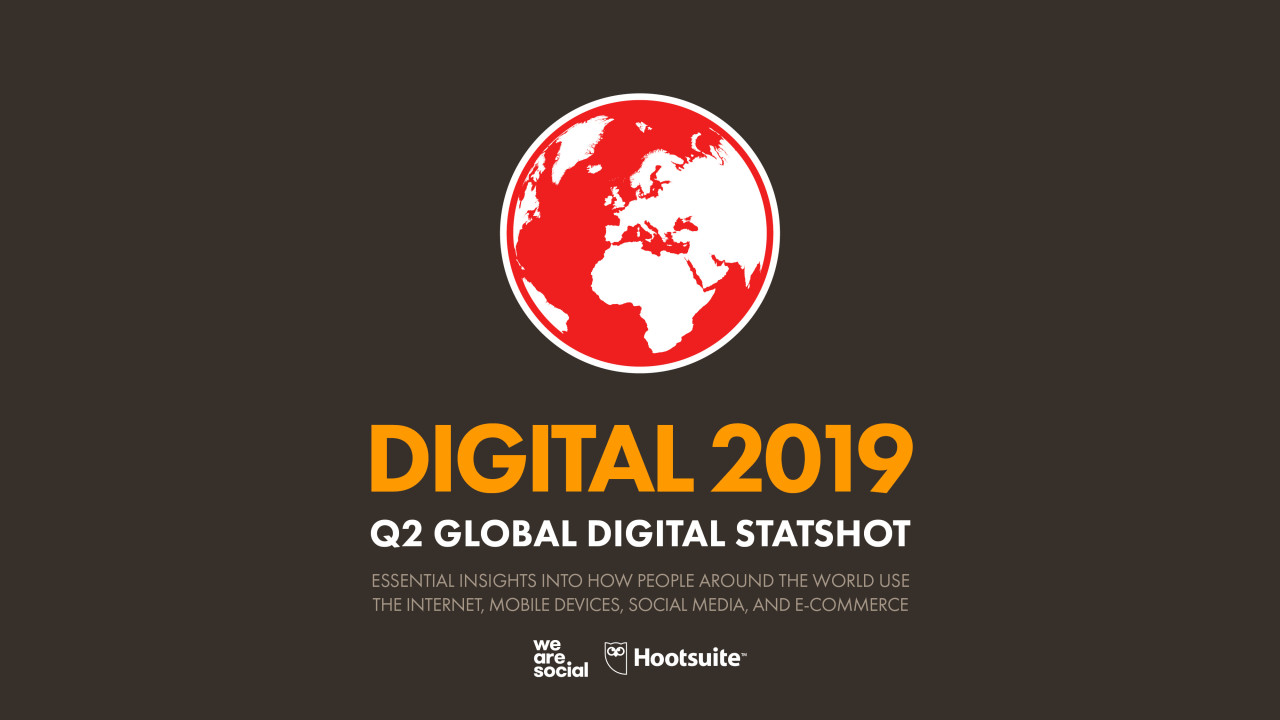
It’s only been three months since I published our first round of Digital 2019 reports here on TNW, but our new Q2 Global Digital Statshot – produced in partnership with We Are Social and Hootsuite – shows that the connected world has already changed considerably during that time.
You’ll find all the latest charts in the SlideShare embed below, but read on for my analysis of all the key trends. Highlights this quarter include some surprise numbers for Instagram and Snapchat, a new entry in our ranking of the world’s top social media platforms, and a closer look at what’s really happening with TikTok.
Essential headlines
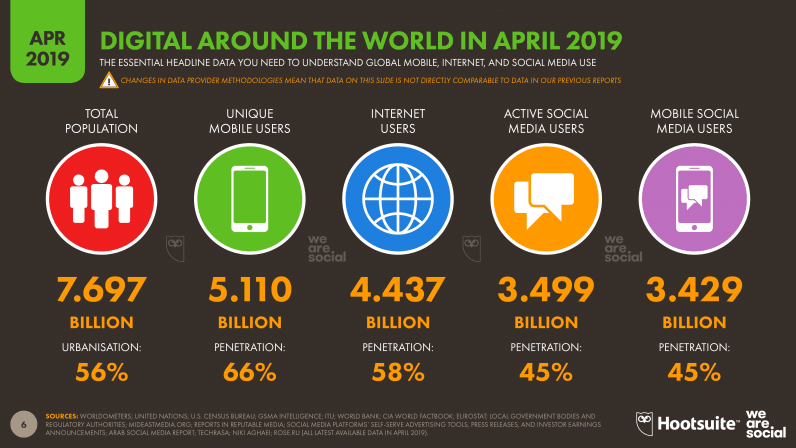
- Global internet users grew by 8.6 percent over the past 12 months, with 350 million new users contributing to an overall total of 4.437 billion by the start of April 2019.
- Social media user numbers have also registered solid growth, increasing by more than 200 million since this time last year to reach almost 3.5 billion by the time of publication. However, recent changes in Facebook’s reporting methodology mean that actual growth was probably even higher, as I’ll explain below.
- There are now more than 5.1 billion people around the world using a mobile phone – a year-on-year increase of 2.7 percent – with smartphones accounting for more than two-thirds of all devices in use today.
- Roughly 98 percent of the world’s social media users – more than 3.4 billion people – access social platforms via mobile devices.
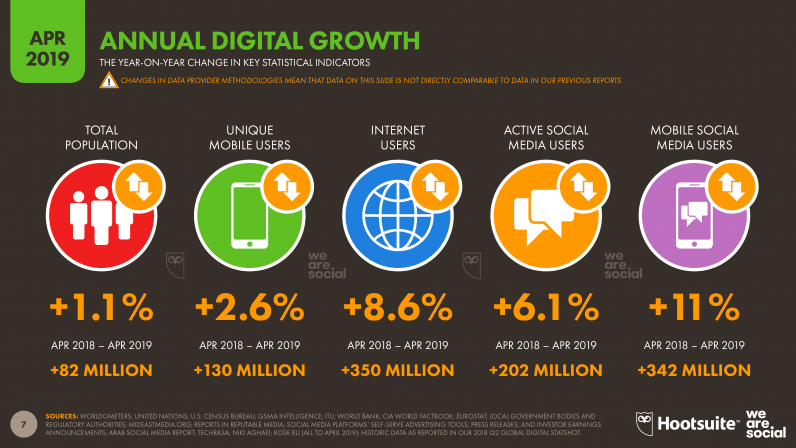
It’s also important to highlight that some changes in this quarter’s datasets mean that various figures in this report are not directly comparable to those we published in previous reports. In particular, changes in Facebook’s reporting methodology have had a significant impact on the audience numbers that the company publishes for both Facebook and Instagram, while revisions to GSMA Intelligence’s data mean that the mobile figures we quote in this report won’t tally with the numbers we published in our January reports.
However, the good news is that these changes have actually revealed some new insights of their own, so let’s dive into the data to find out what they are…
Internet use in April 2019
The latest reported figures suggest that an average of almost 1 million people came online for the first time each day over the past year, continuing the strong growth that we saw in our recent Digital 2019 reports. We’ve made some revisions to our data sources since then though, and without those changes, these growth figures would have been even higher.
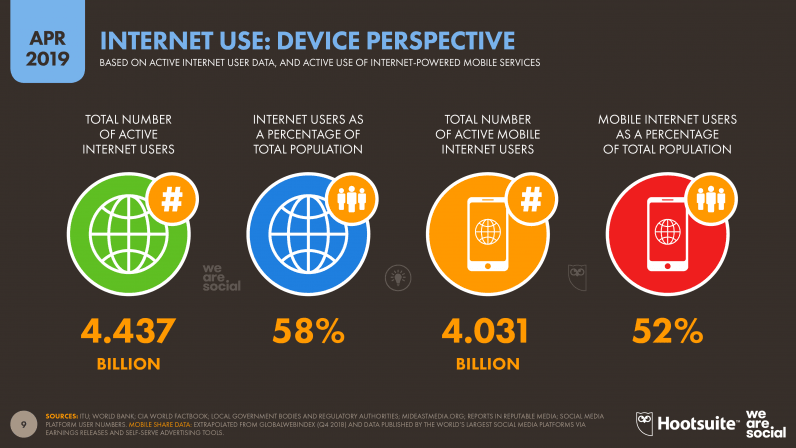
CNNIC’s February 2019 report (in Mandarin) also shows meaningful growth in the number of internet users in China, with the total increasing by 29 million new users since the organization’s previous report in August 2018.
Perhaps unsurprisingly, the vast majority of the world’s internet users now go online via mobile devices, with data from GlobalWebIndex indicating that more than 9 in 10 internet users connect using a mobile phone.
However, the latest data from Statcounter suggest that mobile phones only account for 49 percent of global web traffic, with laptop and desktop computers accounting for almost the same share of activity, at 47 percent.

Firstly, they support the hypothesis that mobile users are increasingly turning to dedicated mobile apps – rather than to the mobile web – to achieve their desired outcomes on mobile devices.
This trend is evident in the latest app store data, too. App Annie reports that mobile app downloads across the Google Play and iOS stores have grown by 10 percent year-on-year, with smartphone users downloading a total of 30 billion apps in the first 3 months of 2019 alone – that’s more than 3,850 downloads every second.
What’s more, App Annie’s figures don’t include downloads from third-party app stores, which account for a significant share of activity in countries like China.
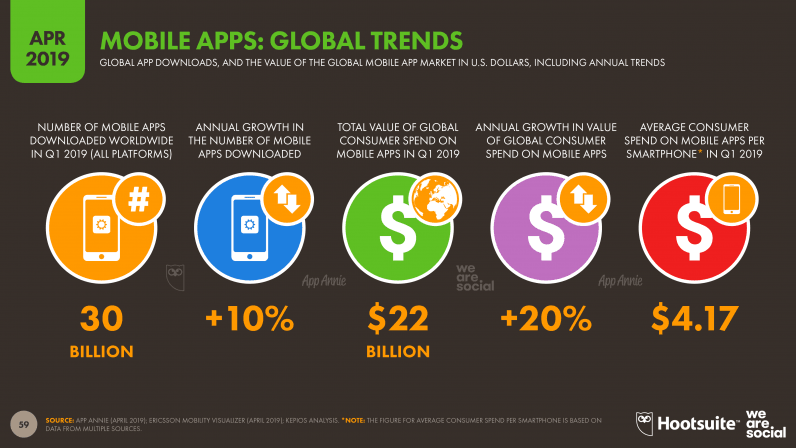
This may be partly because fixed internet connections are still considerably faster than mobile connections. The latest data from Ookla reveal that the average fixed connection is more than twice as fast as the average mobile connection, although we can expect to see this change significantly with the advancing roll-out of 5G mobile networks.
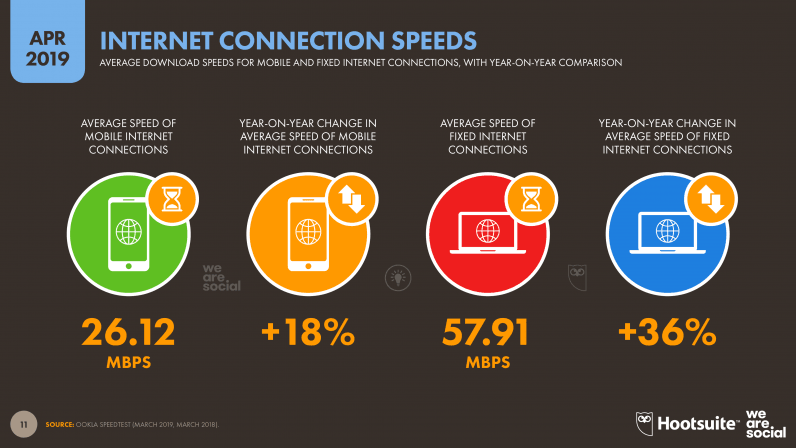
The growing role of voice
GlobalWebIndex’s latest data show that more than 4 in 10 internet users made use of voice commands and voice search in the past 30 days, but that adoption of these tools varies considerably around the world.
Perhaps most tellingly, the use of voice is most common in India, China, and Indonesia – countries that already have some of the world’s largest internet populations, but that are also experiencing some of the greatest increases in new internet users.

This is particularly true of younger users, many of whom have not yet developed ‘fixed’ habits when it comes to using digital devices and services. Indeed, the latest data from GlobalWebIndex shows that almost half of all internet users aged 16 to 24 already use voice, compared to less than 30 percent of users aged 45 and above.

In particular, for people with lower levels of literacy, and for people who speak languages with character sets that aren’t yet available as smartphone keypads, voice is the default interface for almost all of their digital activities.
Considering that a disproportionate share of the people coming online for the first time today fall into these two groups, it’s likely that we’ll see voice adoption accelerate in the coming months.
Meanwhile, the desire to achieve economies of scale means that the trend towards increasing adoption of voice in the world’s largest internet populations will likely translate into an imperative for developers to move voice functionality to the center of the experience for all users around the world – even in developed nations.
Social media use in April 2019
The number of people around the world using social media continues to increase, but – as I noted above – some important changes in platform reporting definitions and methodologies mean that growth figures look a bit softer than they have done in previous quarters.
However, it’s important to stress that this softness is purely due to those changes in reporting, and it should not be interpreted as an actual slowdown in user growth.
Almost 3.5 billion people around the world now use social media, with roughly 98 percent of them accessing social platforms via mobile devices.

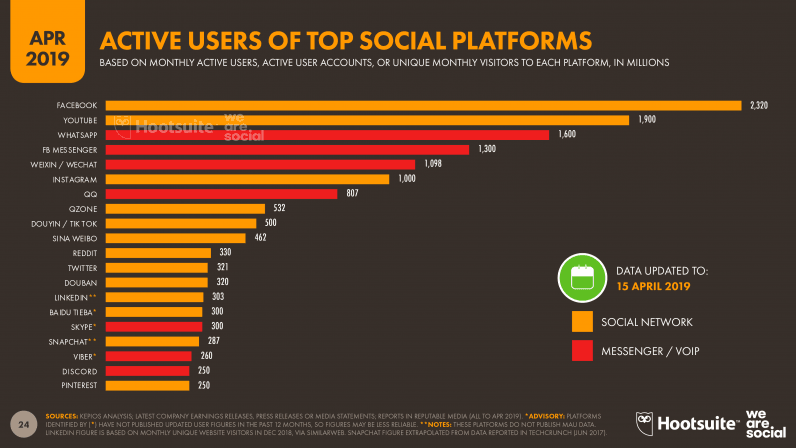

1. Facebook
Facebook recently made some fundamental changes to the ways in which it reports advertising audience numbers across its various platforms, and – sadly – these changes mean that we’re unable to report like-for-like growth trends this quarter.
As Facebook states in its Ad Help Center:
Estimated potential reach is now based on how many people have been shown an ad on a Facebook Product in the past 30 days. We previously based estimates on people who were active users in the past 30 days. — [shortened for clarity]
However, these changes are actually quite helpful: firstly, they enable advertisers to build a clearer picture of the number of people they’re able to reach with ads on each of Facebook’s platforms, and secondly, they provide investors with a better understanding of how well Facebook is ‘monetizing’ its platforms’ users.
This second point is a good place to start our analysis, because the new figures reveal some interesting insights into Facebook’s performance as a business.
In its Q4 2018 earnings announcement back in January, Facebook reported a total monthly active user base of 2.320 billion users on the core Facebook platform – i.e. not including figures for Instagram and WhatsApp.
Meanwhile, the latest figures the company is reporting in its self-serve advertising tools suggest that Facebook showed adverts to 1.887 billion of these users in the past 30 days.
That means that Facebook is monetizing roughly 81 percent of its total active user base.
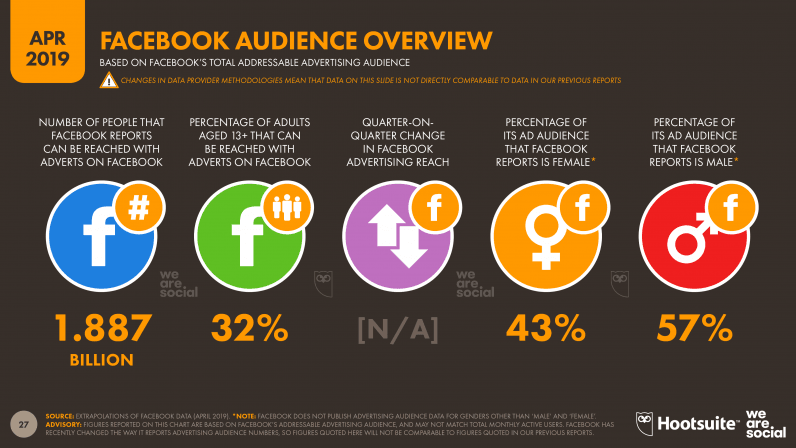
But the good news for Facebook is that these changes in reporting appear to have improved the company’s story when it comes to user activity on the platform.
Whereas the company’s Insights tools had been showing steady declines in users’ median number of ad clicks over the past three quarters, the latest data show much healthier figures.
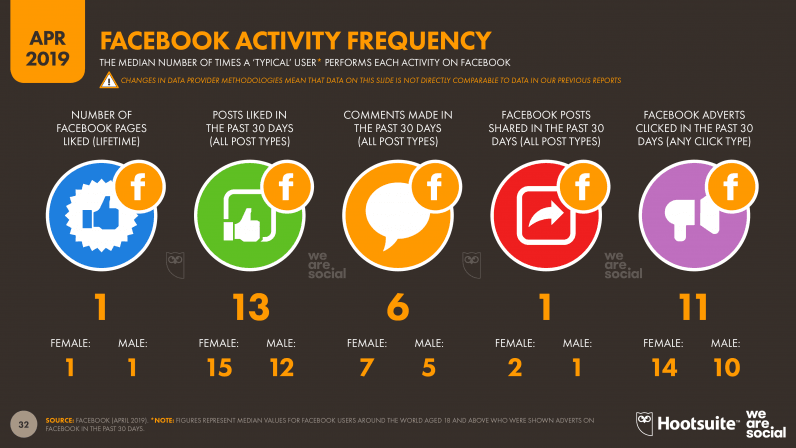
Indeed, the latest insights from Locowise reveal that engagement with Facebook Page posts continues to decline, with the average post now garnering a response rate of just 3.6 percent – a relative drop of 3.4 percent in just the past three months.

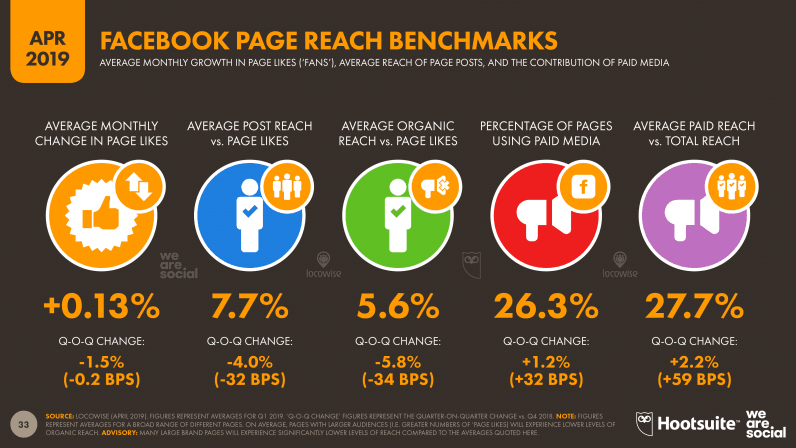

Locowise reports that more than a quarter of the Pages that it tracks invest in some form of paid promotion, which would indicate that – globally – more than 20 million businesses now invest in Facebook’s paid media products.
2. Instagram
Facebook has made the same definition changes in its reporting of Instagram audiences, and – interestingly – this has resulted in similar patterns to those we saw above for Facebook.
Instagram announced that it had passed the billion active accounts milestone back in June 2018, but the latest figures in Facebook’s self-serve advertising tools suggest that the company only showed adverts to 802 million Instagram users in March 2019.
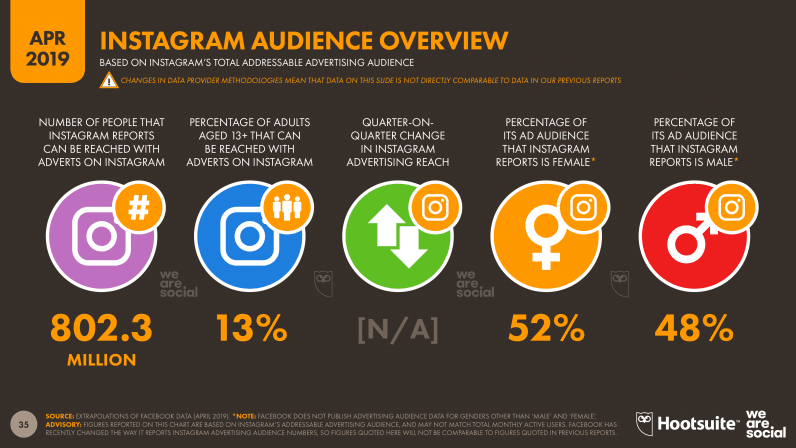
However, the good news is that data that we do have still tell an interesting story.
Despite media speculation that teenagers have been flocking to Instagram in recent months, the advertising audience data that we collected prior to the recent change in Facebook’s audience definitions show that the number of Instagram users aged 13 to 17 actually fell by more than 3 percent between October 2018 to January 2019.
But as you can see in the chart below, it’s only this younger group that’s affected; all other age groups showed very healthy growth, and overall, the size of Instagram’s advertising audience actually increased by more than 4 percent during the same period (October 2018 to January 2019).

The definition changes have revealed some interesting new insights, though. By comparing the relative changes in audience sizes, we’ve been able to identify that advertisers have been disproportionately targeting Instagram’s younger, female users, which has likely led to an increase in the number of sponsored posts that these specific users have been seeing.
The available data don’t show whether this increase in advertising has contributed to the decline in Instagram’s younger users that we explored above, but it’s certainly a provocative hypothesis. If this were indeed the case, the Instagram team would face the awkward conundrum of whether to reduce the amount of advertising it shows to these audiences, sacrificing short-term growth in order to keep these valuable younger audiences for the longer term.
But – perhaps more importantly – if Instagram is losing younger audiences, the big question is: where are they going?
As usual, there’s plenty of speculation here, so let’s look at what the data tells us…
3. TikTok
In my recent conversations with senior marketers, journalists, and even the world’s biggest investors, it’s clear that many people believe TikTok is “the next big thing” in the world of social.
And with the company already claiming more than 500 million active users – and more than a billion downloads – it’s easy to see why.
TikTok doesn’t publish audience figures to the same level as peers like Snapchat and Instagram though, so we need to look at some different data sources to get a sense of TikTok’s current status and growth.
A good place to start is Google Trends, which shows that worldwide interest in TikTok has grown significantly over the past year.
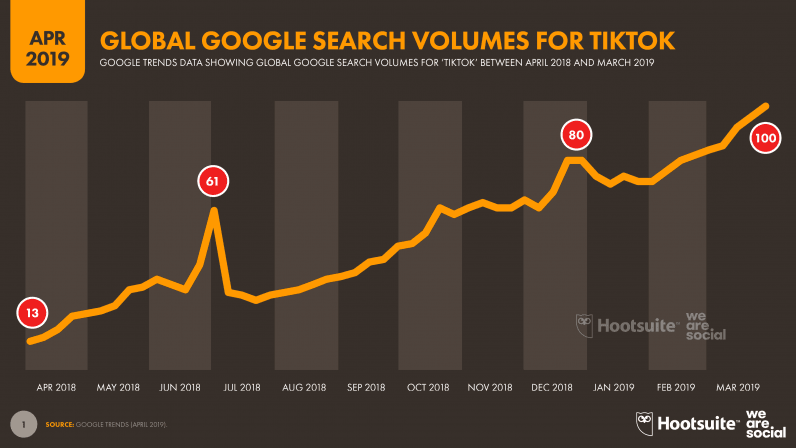
But how does the platform compare to its peers? Google Trends data shows that worldwide interest in TikTok is already on a par with Snapchat (note that the TikTok trendline in the chart below also includes searches for “Tik Tok” – i.e. with a space – which appears to be a common variation in spelling for searches relating to the platform).

The data I’ve been exploring don’t always tell a good story for TikTok, either. Some app download trends tell very different stories to those we see in the Google Trends numbers above, with some even suggesting that we may have passed ‘peak TikTok’ in key Western markets.
For example, the chart below tracks TikTok’s position in App Annie’s daily download rank for all apps in the iPhone app store in the UK and USA between January 20 and April 19 in 2019, and the trendlines tell a clear – and somewhat worrying – story.
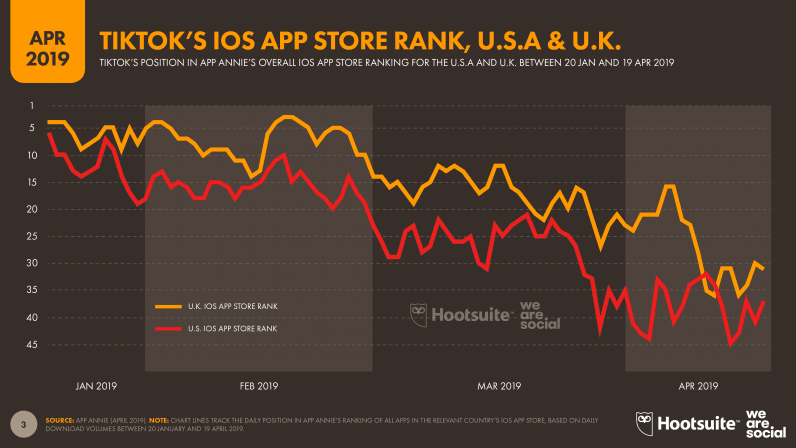
SensorTower reports that TikTok added 188 million new users in the first three months of this year, and the company ranks the app as the number one top performer in Apple’s iOS app stores for Q1 2019.
Meanwhile, App Annie reports that TikTok ranked fourth overall in the world’s most downloaded apps across iOS and Google Play stores for the whole of Q1.
That puts TikTok behind Facebook, Messenger, and WhatsApp, but ahead of Instagram:
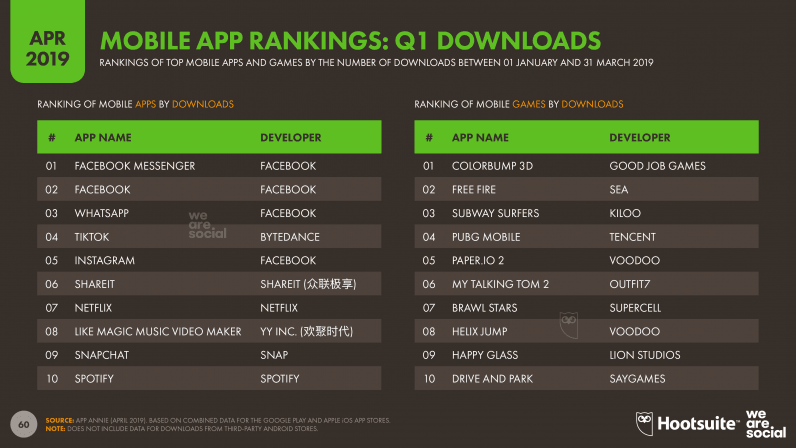
4. Snapchat
After a worrying start to the year, Snapchat saw some more reassuring trends in its advertising audience numbers this quarter, with the platform’s total addressable audience growing by 1.2 percent since January.
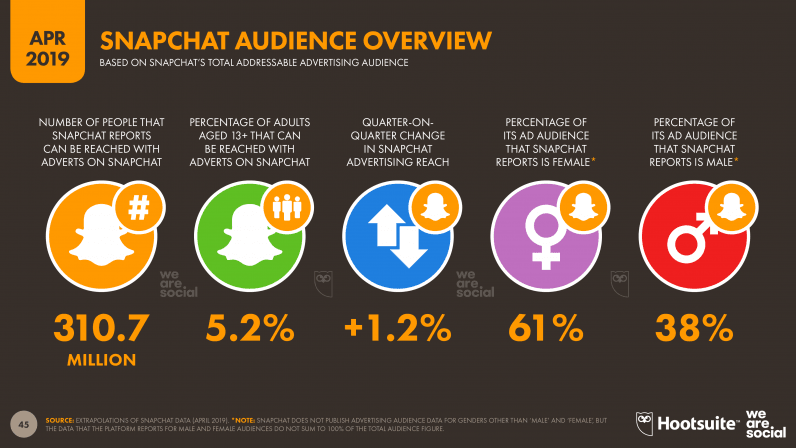
Snapchat also saw disproportionate growth in Russia this quarter, with the platform’s audience in the country up by almost 8 percent in the past three months.
Interestingly, Snapchat’s self-serve advertising tools also report a slight increase in the size of the platform’s audience in the United States – a finding which seems to go against media speculation that the platform would see declines in its US user base this year.
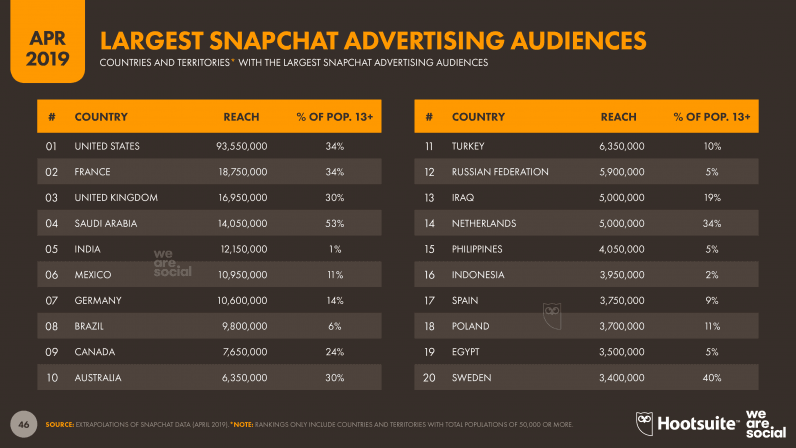
It’s not all good news for Evan Spiegel and team, though. Snapchat saw its male audience decline by an average of 0.3 percent over the past three months, with males aged 13 to 17 down by 1.4 percent during the same period, and males aged 18 to 20 down almost 3 percent.
However, this was more than offset by the growth in female audiences. Overall, the number of women that advertisers can reach on Snapchat has grown by more than 2 percent since January, while the number of women aged 13 to 17 has grown even faster – up 5.6 percent in just three months.
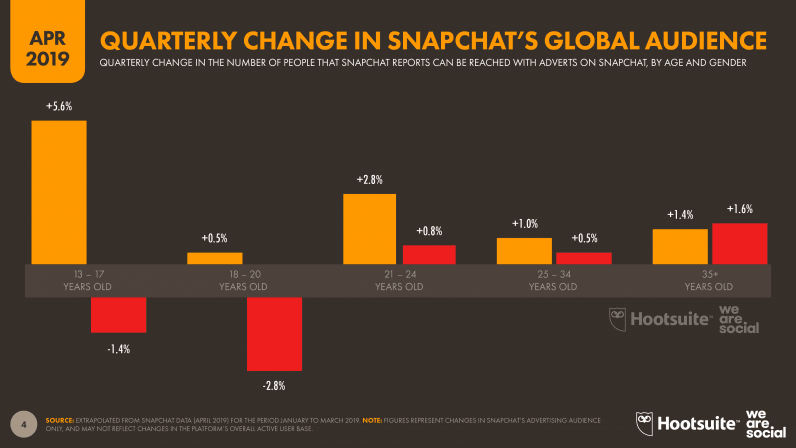
5. Twitter
The figures that Twitter publishes in its self-serve advertising tools tend to fluctuate significantly – even over short periods of time – which can make it trickier to identify precise trends for the platform.
However, the latest data suggest that Twitter also saw overall growth in its advertising audience in the first three months of 2019, with the global addressable audience up by 4.5 percent since January.
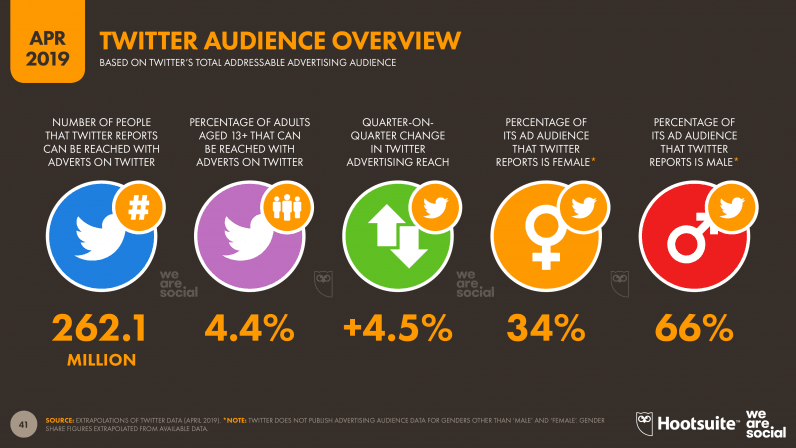
Meanwhile, Twitter’s self-serve advertising tools also show an audience increase of almost 2.5 million in the United States, equating to quarter-on-quarter growth of more than 5 percent.
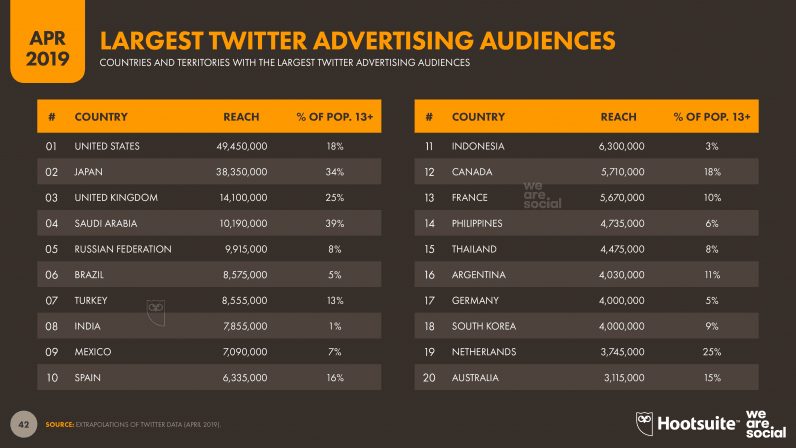
6. LinkedIn
The world’s most active professional social network saw good growth again in the first quarter of 2019, with the platform’s self-serve advertising tools reporting an increase of 1.7 percent in its total addressable audience.
Advertisers can now reach almost 615 million people on LinkedIn, although it’s worth highlighting that these figures are based on registered users, rather than the monthly active user figures reported by most other platforms.
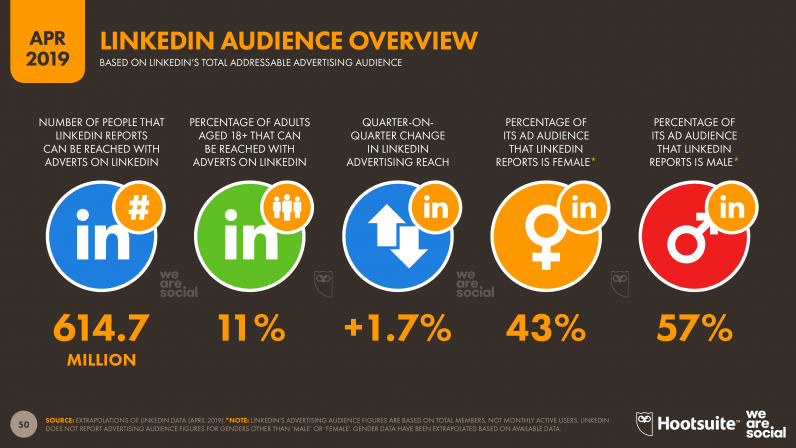

7. Discord
Discord is a new entrant to our ranking of the world’s most active social platforms, having recently exceeded a quarter of a billion active users.
Discord is a messaging platform that’s hugely popular with the world’s billion-plus online gamers, which should be more than enough reason for marketers need to add it to their list of potential opportunities.
However, it’s Discord’s focus on communities that makes it particularly interesting as a platform, especially in a world where privacy concerns are increasingly important drivers of people’s social media preferences and behavior.
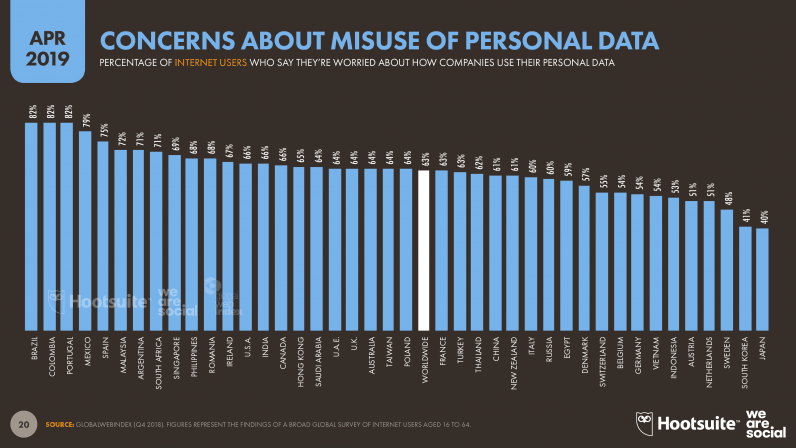
Perhaps more importantly than growth, however, Discord’s compelling blend of interest-based communities – or ‘servers’ – together with its public and private messaging, mean that Discord may well have a disproportionate impact on how the overall social media landscape evolves in the coming months.
In particular, given Mark Zuckerberg’s penchant for ‘taking inspiration’ from other platforms’ features, I wouldn’t be surprised to see various elements of Discord’s architecture appear in the more privacy-focused offerings he promised in a recent announcement.
If you’re new to Discord, or if you’d like a handy explainer, check out this great overview video from CNBC, complete with excellent stats and founder interviews:
Mobile use in April 2019
Our partners at GSMA Intelligence have revised their historical data for unique mobile users since January, but the worldwide total has since returned to the figure of 5.11 billion that we reported in our Digital 2019 report.
After the revisions, GSMA Intelligence reports that unique mobile users have grown by roughly 2.6 percent over the past twelve months, equating to an additional 130 million new mobile users since this time last year.
Note that we’ve changed the way we report mobile subscriptions too, and the 7.787 billion figure we’re quoting in this quarter’s report no longer includes IoT connections.
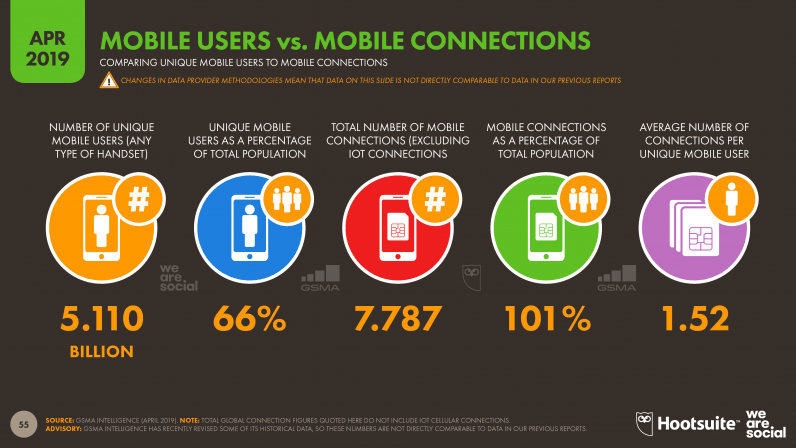
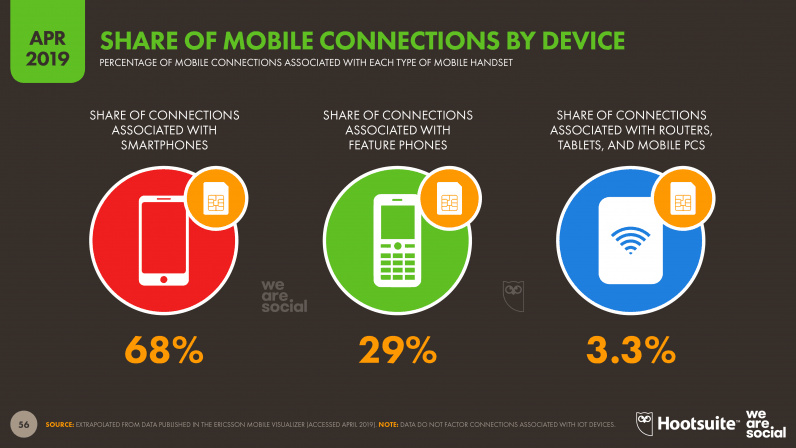
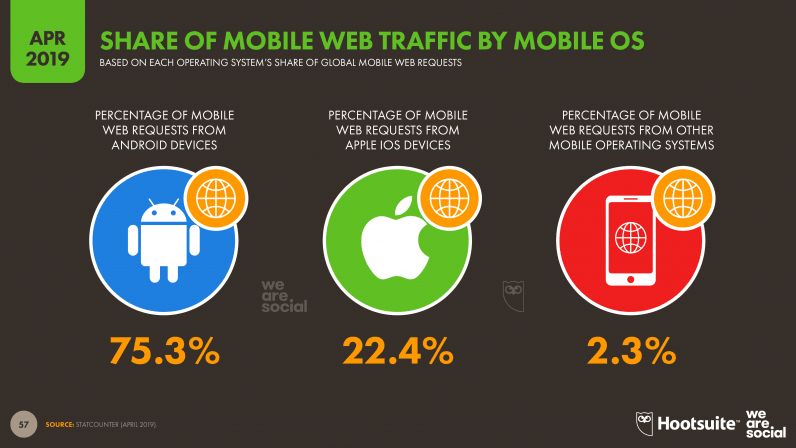
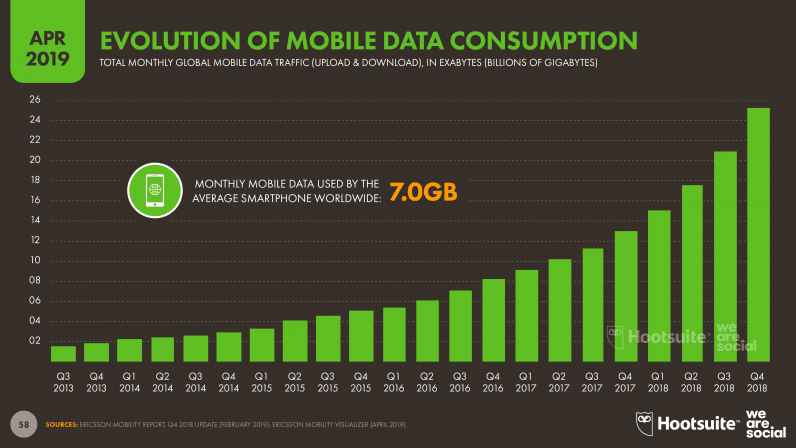
Making sense of the future
Hopefully all that data has given you an excellent perspective on the state of digital in April 2019. However, it’s only when we act on data that it can start to deliver value.
That’s not always easy though, so if you’d like some help translating all of these numbers into sharper insights and more actionable tips, you’ll want to join me at the TNW Conference in Amsterdam on May 9 and 10.
I’ll be delivering the closing keynote on the Re:brand stage at the end of day one, and I’d love to see you there, so go grab your tickets now.
Get the TNW newsletter
Get the most important tech news in your inbox each week.





